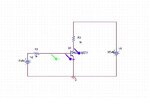DEV123
Member level 2
Hi all,
I have a doubt regarding saturation mode of BJT. Saturation occurs when both emitter-base junction and base-collector junction gets forward biased. For forward biasing a silicon p-n junction only 0.7V is needed. So is for emitter-base junction. But not for base-collector junction. Because we know at saturation voltage across collector and emitter Vce is 0.2V. Using Kirchoff's voltage laws the voltage at base-collector p-n junction is less than 0.7V. Why is it lesser?
-Devanand T
I have a doubt regarding saturation mode of BJT. Saturation occurs when both emitter-base junction and base-collector junction gets forward biased. For forward biasing a silicon p-n junction only 0.7V is needed. So is for emitter-base junction. But not for base-collector junction. Because we know at saturation voltage across collector and emitter Vce is 0.2V. Using Kirchoff's voltage laws the voltage at base-collector p-n junction is less than 0.7V. Why is it lesser?
-Devanand T

